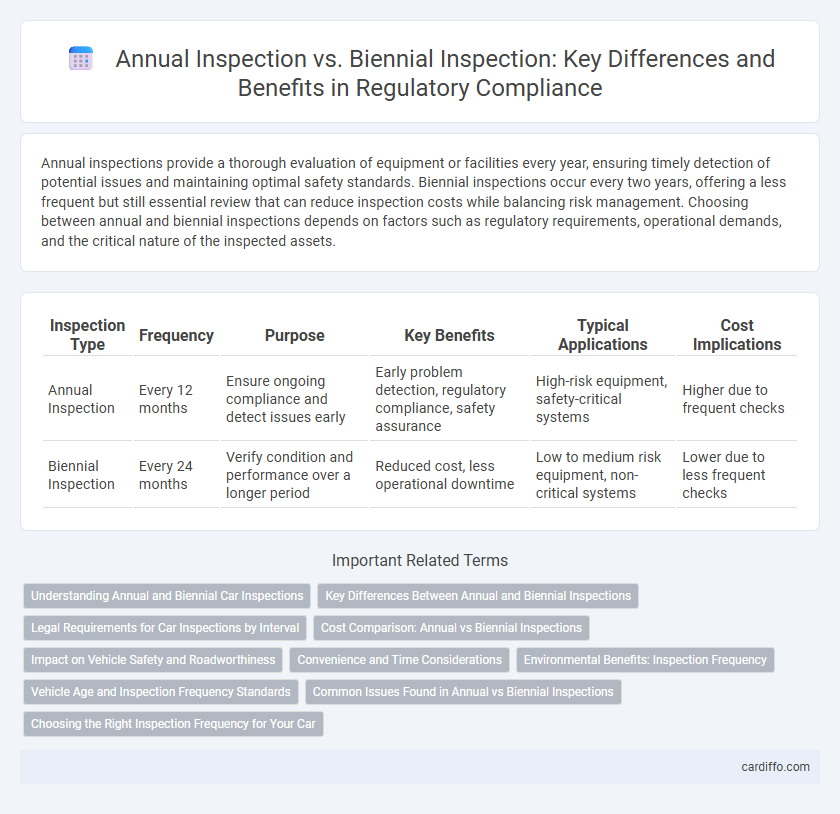Annual inspections provide a thorough evaluation of equipment or facilities every year, ensuring timely detection of potential issues and maintaining optimal safety standards. Biennial inspections occur every two years, offering a less frequent but still essential review that can reduce inspection costs while balancing risk management. Choosing between annual and biennial inspections depends on factors such as regulatory requirements, operational demands, and the critical nature of the inspected assets.
Table of Comparison
| Inspection Type | Frequency | Purpose | Key Benefits | Typical Applications | Cost Implications |
|---|---|---|---|---|---|
| Annual Inspection | Every 12 months | Ensure ongoing compliance and detect issues early | Early problem detection, regulatory compliance, safety assurance | High-risk equipment, safety-critical systems | Higher due to frequent checks |
| Biennial Inspection | Every 24 months | Verify condition and performance over a longer period | Reduced cost, less operational downtime | Low to medium risk equipment, non-critical systems | Lower due to less frequent checks |
Understanding Annual and Biennial Car Inspections
Annual car inspections require vehicle owners to undergo a complete safety and emissions check every 12 months, ensuring consistent compliance with regulations and early identification of potential issues. Biennial inspections, conducted every two years, offer a less frequent review schedule that may reduce inspection costs but increases the risk of undetected vehicle problems over longer periods. Understanding the differences between annual and biennial inspections helps car owners balance maintenance rigor with convenience, ultimately supporting safer driving conditions and regulatory adherence.
Key Differences Between Annual and Biennial Inspections
Annual inspections occur every 12 months, providing frequent evaluations that help identify and address potential issues promptly, enhancing safety and compliance. Biennial inspections, conducted every two years, offer a cost-effective approach but may delay the detection of emerging problems, potentially increasing maintenance risks. Key differences lie in frequency, cost, and risk management, with annual inspections enabling more proactive care compared to the less frequent, but budget-friendly biennial inspections.
Legal Requirements for Car Inspections by Interval
Car inspection requirements vary by jurisdiction, with annual inspections mandated in many regions to ensure ongoing vehicle safety and emissions compliance. Some areas permit biennial inspections, reducing the frequency to every two years, provided vehicles meet specific age or condition criteria established by local laws. Compliance with these legal intervals is crucial to avoid penalties and maintain vehicle registration validity.
Cost Comparison: Annual vs Biennial Inspections
Annual inspections typically incur higher total costs due to more frequent fees and potential downtime, while biennial inspections reduce immediate expenditures but may lead to increased repair costs from less frequent maintenance. Companies must balance upfront inspection expenses against the risk of costly damages that timely annual inspections might prevent. Cost efficiency depends on asset type, usage intensity, and industry regulations influencing inspection intervals.
Impact on Vehicle Safety and Roadworthiness
Annual inspections thoroughly assess critical vehicle systems such as brakes, tires, and emissions to ensure consistent roadworthiness and prevent mechanical failures. Biennial inspections, conducted every two years, may allow minor issues to go unnoticed longer, potentially compromising vehicle safety and increasing the risk of accidents. Regular annual checks improve early detection of defects, maintaining optimal vehicle performance and compliance with safety regulations.
Convenience and Time Considerations
Annual inspections offer greater convenience by providing more frequent monitoring, which helps identify and address issues early, potentially reducing costly repairs. Biennial inspections save time overall by requiring fewer appointments, making them suitable for equipment or properties with stable conditions. Choosing between annual and biennial inspections depends on balancing the need for timely maintenance with the availability of time for scheduling and conducting inspections.
Environmental Benefits: Inspection Frequency
Annual inspections identify environmental hazards more frequently, reducing the risk of pollution and promoting quicker remediation of issues such as leaks or emissions. Biennial inspections, while less frequent, still contribute to environmental protection by maintaining compliance with regulations and minimizing disruptive intervention. Choosing the optimal inspection frequency balances environmental benefits with resource allocation and operational continuity.
Vehicle Age and Inspection Frequency Standards
Vehicles under five years old typically require annual inspections to ensure compliance with safety and emissions standards. Older vehicles, especially those exceeding ten years, often fall under biennial inspection regulations aimed at balancing safety with inspection resource allocation. Regulatory agencies set these inspection frequency standards based on vehicle age to optimize road safety and environmental impact assessments.
Common Issues Found in Annual vs Biennial Inspections
Annual inspections commonly uncover wear and tear issues such as corrosion, worn seals, and minor leaks that develop quickly over a year. Biennial inspections tend to reveal more significant problems like structural fatigue, electrical system degradation, and major component failures due to the extended interval between assessments. Identifying these issues early during annual or biennial inspections is crucial for maintaining safety standards and preventing costly repairs.
Choosing the Right Inspection Frequency for Your Car
Choosing the right inspection frequency for your car depends on factors such as vehicle age, mileage, and manufacturer recommendations. Annual inspections offer comprehensive checks ideal for older vehicles or those with high mileage, ensuring safety and early detection of issues. Biennial inspections work well for newer cars with lower mileage, balancing convenience with regulatory compliance and cost savings.
Annual inspection vs biennial inspection Infographic

 cardiffo.com
cardiffo.com